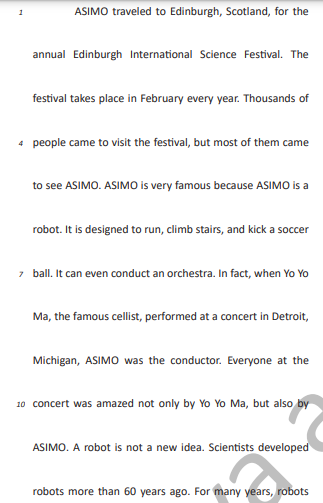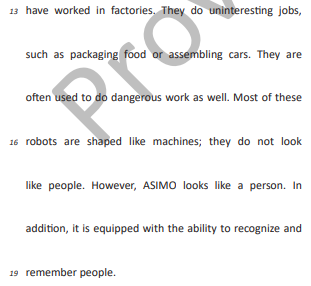Questões de Concurso
Sobre interpretação de texto | reading comprehension em inglês
Foram encontradas 9.434 questões
Text 3
Benefits of a Bilingual Brain
¹ Language ability is typically measured in two active parts, speaking and writing, and two passive parts, listening and reading. While a balanced bilingual has near equal abilities in two languages, most bilinguals around the world know and use their languages in varying proportions. But recent advances in brain imaging technology have given neurolinguists a glimpse into how specific aspects of language learning affect the bilingual brain.
² It's well known that the brain's left hemisphere is more dominant and analytical in logical processes, while the right hemisphere is more active in emotional and social ones, though this is a matter of degree, not an absolute split. The fact that language involves both types of functions has led to the critical period hypothesis. According to this theory, children learn languages more easily because the plasticity of their developing brains lets them use both hemispheres in language acquisition, while in most adults, language is lateralized to one hemisphere, usually the left. If this is true, learning a language in childhood may give you a more holistic grasp of its social and emotional contexts.
³ Conversely, recent research showed that people who learned a second language in adulthood exhibit less emotional bias and a more rational approach when confronting problems in the second language than in their native one. But regardless of when you acquire additional languages, being multilingual gives your brain some remarkable advantages, such as higher density of the grey matter that contains most of your brain's neurons and synapses, and more activity in certain regions when engaging a second language. The strong workout a bilingual brain receives throughout its life can also help delay the onset of diseases, like Alzheimer's and dementia by as much as five years.
Source: Adapted from “Benefits of a bilingual brain” (Video),
by Mia Nacamuli for TED-ed, 2015. Available on:
https://www.youtube.com/watch?v=MMmOLN5zBLY with
subtitles.
I. There are various methods that could help an adult learner acquire a second language, for example communicative language teaching, task based learning or the direct method.
II. The Critical Period Hypothesis described in the ‘Text 3’ explains how children are more likely to learn a second language than an adult learner.
Choose the CORRECT answer:
Text 3
Benefits of a Bilingual Brain
¹ Language ability is typically measured in two active parts, speaking and writing, and two passive parts, listening and reading. While a balanced bilingual has near equal abilities in two languages, most bilinguals around the world know and use their languages in varying proportions. But recent advances in brain imaging technology have given neurolinguists a glimpse into how specific aspects of language learning affect the bilingual brain.
² It's well known that the brain's left hemisphere is more dominant and analytical in logical processes, while the right hemisphere is more active in emotional and social ones, though this is a matter of degree, not an absolute split. The fact that language involves both types of functions has led to the critical period hypothesis. According to this theory, children learn languages more easily because the plasticity of their developing brains lets them use both hemispheres in language acquisition, while in most adults, language is lateralized to one hemisphere, usually the left. If this is true, learning a language in childhood may give you a more holistic grasp of its social and emotional contexts.
³ Conversely, recent research showed that people who learned a second language in adulthood exhibit less emotional bias and a more rational approach when confronting problems in the second language than in their native one. But regardless of when you acquire additional languages, being multilingual gives your brain some remarkable advantages, such as higher density of the grey matter that contains most of your brain's neurons and synapses, and more activity in certain regions when engaging a second language. The strong workout a bilingual brain receives throughout its life can also help delay the onset of diseases, like Alzheimer's and dementia by as much as five years.
Source: Adapted from “Benefits of a bilingual brain” (Video),
by Mia Nacamuli for TED-ed, 2015. Available on:
https://www.youtube.com/watch?v=MMmOLN5zBLY with
subtitles.
I. By skimming the text, it is possible to say the main idea of the text is how bilingualism can make you smarter.
II. By scanning text 3, it is NOT possible to answer the question: "Are bilinguals the majority in the world?"
III. By inference, it is possible to say that people who learnt a second language in younger years show more emotional bias when confronting problems in their second language.
Choose the CORRECT answer:
I. In: "So you stand by the board / full of fear and intention",‘fear’ could be changed to 'self-respect' to match intention,as it introduces the teacher in class.
II. In: "Sleep transports sadness / to some other mid-brain",mid-brain could possibly mean 'to another place'.
Choose the CORRECT answer:
I. According to the text, Spanglish can be used when speakers change from English to Spanish completely in a conversation.
II. It can be inferred from the text that because there are more Hispanic speakers in the U.S now, Spanglish is also becoming more prominent.
III. It is said in the text that the political operatives are interested in the young Hispanic population only, since they want to meet the nation's changing demographics.
Choose the CORRECT answer:
I. The text is an example of a news article, as it contains factual information and it is written in third person.
II. In the opening paragraph, by introducing a real example of a Spanglish speaker, the author of the text probably attempted to support the relevance of the topic.
III. The sentence above the text: “In an effort to attract younger Hispanic voters, campaigns are turning to Spanglish” is a headline.
Choose the CORRECT answer:
Concerning the text, judge the item.
The terms “However” (line 17) and “In addition” (lines
17 and 18) can be correctly replaced by Hence and
Therefore, respectively
Concerning the text, judge the item.
The adverb “often” (line 15) indicates something that
happens not very frequently.
Concerning the text, judge the item.
The subject pronoun in the sentence
“It is designed to run, climb stairs, and
kick a soccer ball” (lines 6 and 7) refers
to ASIMO.
Concerning the text, judge the item.
The expression “such as” (line 14) is used to introduce
an example or a list of examples.
Concerning the text, judge the item.
The term “they” (line 13) refers to robots from the
previous sentence.
Concerning the text, judge the item.
Yo Yo Ma is a famous robot that played in a concert in
Detroit conducted by ASIMO.
Concerning the text, judge the item.
ASIMO can do things related to sports and music. It
can also recognize a human.
Concerning the text, judge the item.
Everyone goes to the festival only to see ASIMO.
Concerning the text, judge the item.
The date of the festival is not mentioned in the text.
Concerning the text, judge the item.
The science festival happens once a year in Edinburgh.


